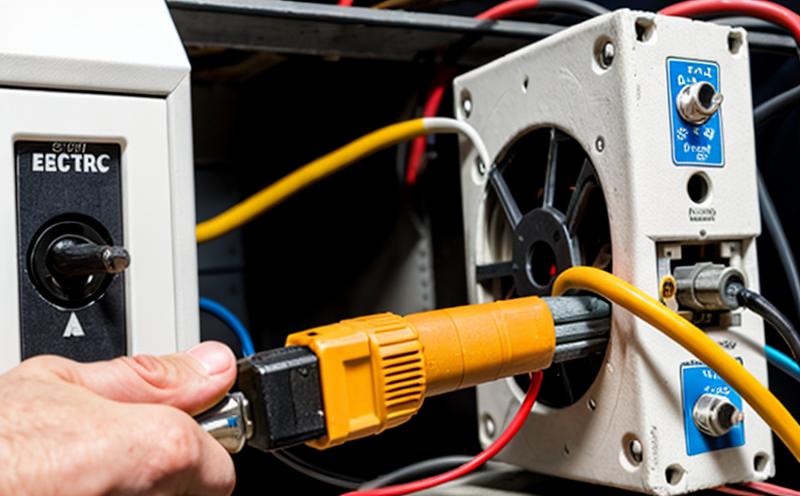IEC 61000-4-15 Flicker and Fluctuation Test
The IEC 61000-4-15 standard is a critical part of the International Electrotechnical Commission's (IEC) suite of standards for electromagnetic compatibility (EMC). This test focuses on flicker and fluctuation, which are significant factors in electrical safety and EMC. Flicker can cause visual discomfort and pose potential health risks to individuals working or living near lighting systems, while fluctuations can affect the quality of power supply and lead to operational issues in sensitive electronic devices.
In an increasingly interconnected world where smart technologies dominate homes and industries, ensuring that all equipment operates within safe limits is paramount. This test ensures compliance with safety regulations and helps manufacturers meet stringent international standards for electrical products. By adhering to these guidelines, businesses can minimize the risk of product recalls due to non-compliance and enhance their reputation in the market.
The IEC 61000-4-15 standard addresses both visual flicker and power fluctuation phenomena. Visual flicker is defined as a phenomenon where the brightness or color of an electric light source changes rapidly, potentially causing discomfort to observers. Power fluctuations refer to variations in voltage or current that can disrupt normal operation of electrical equipment.
The test protocol involves simulating real-world conditions under which electrical devices may operate. Specimens are subjected to various input voltages and frequencies, mimicking the power grid's behavior during peak demand periods. The system measures the resulting output light intensity variations and compares them against predefined thresholds set forth in IEC 61000-4-15.
Compliance with this standard is essential for several reasons. First, it protects end users from potential harm caused by excessive flicker or fluctuation. Second, compliance enhances the reliability of electrical systems by ensuring that equipment can handle typical variations in power supply without malfunctioning. Lastly, adherence to these standards fosters trust between manufacturers and consumers, thereby promoting long-term relationships.
For R&D engineers involved in designing new products or improving existing ones, understanding flicker and fluctuation is crucial for creating innovative solutions. They must consider how different components interact within the overall system when addressing flicker issues. Additionally, they need to ensure that their designs can withstand fluctuations without compromising performance. Compliance with IEC 61000-4-15 also provides a competitive advantage by demonstrating commitment to safety and quality.
Manufacturers responsible for procuring components or outsourcing production should prioritize suppliers who have experience conducting flicker and fluctuation tests according to this standard. This ensures consistency across the supply chain, reducing risks associated with non-compliant parts entering final assemblies. Quality managers overseeing production processes benefit from regular testing results as they help identify areas needing improvement.
Understanding the nuances of IEC 61000-4-15 allows stakeholders to make informed decisions about product development and quality assurance practices. Familiarity with its requirements enables them to anticipate challenges early on, allowing for timely adjustments during design phases or manufacturing processes. Ultimately, embracing this standard contributes positively towards building safer, more reliable electrical products that contribute to overall societal well-being.
Why It Matters
The importance of flicker and fluctuation testing cannot be overstated in today’s rapidly evolving technological landscape. As we rely increasingly on electronic devices for daily activities, ensuring their safe operation becomes more critical than ever before. By addressing these parameters through rigorous testing protocols like IEC 61000-4-15, manufacturers demonstrate their commitment to maintaining high standards of safety and reliability.
Reduces Health Risks: Excessive flicker can lead to visual discomfort or even trigger seizures in susceptible individuals. Fluctuations in power supply might cause equipment malfunctions leading to potential hazards.
Enhances Product Reliability: Ensuring that devices perform consistently under varying conditions improves customer satisfaction and reduces warranty claims.
Promotes Consumer Trust: Meeting internationally recognized standards builds confidence among buyers regarding the quality of purchased goods.
Facilitates Regulatory Compliance: Adherence to these guidelines helps avoid penalties imposed by regulatory bodies for non-compliance.
In summary, flicker and fluctuation testing plays a vital role in safeguarding public health while enhancing product performance. It fosters trust between manufacturers and consumers, ensuring that electrical equipment meets the highest levels of safety and reliability.
Scope and Methodology
| Aspect | Description |
|---|---|
| Flicker Measurement | Utilizes photometers to measure the apparent power factor of light sources under different input voltage conditions. |
| Fluctuation Evaluation | Involves monitoring current and voltage variations over specified time intervals using specialized measurement instruments. |
| Environmental Conditions | Tests conducted in controlled environments simulating real-world scenarios such as industrial plants or residential settings. |
The IEC 61000-4-15 standard specifies detailed procedures for conducting flicker and fluctuation tests. These include setting up appropriate test setups, selecting suitable measurement devices, and establishing criteria for acceptable results. The aim is to provide consistent and reproducible outcomes that accurately reflect the actual performance of electrical equipment.
For flicker testing, photometers are used to measure the apparent power factor (APF) of light sources under various input voltage conditions. This allows for precise quantification of flicker levels experienced by observers. In fluctuation evaluation, specialized measurement instruments monitor current and voltage variations over specified time intervals. These data points form the basis for determining whether equipment complies with acceptable limits.
Tests are conducted in controlled environments designed to simulate real-world conditions encountered during typical usage scenarios. This ensures that results obtained are representative of actual field performance. By following these standardized procedures, laboratories can provide accurate and reliable assessments that contribute significantly towards maintaining high standards within the industry.





